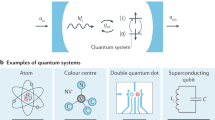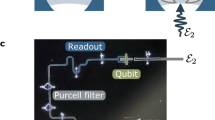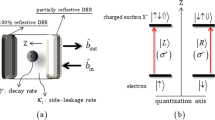Abstract
The strong-coupling regime of cavity quantum electrodynamics (QED) represents the light–matter interaction at the fully quantum level. Adding a single photon shifts the resonance frequencies—a profound nonlinearity. Cavity QED is a test bed for quantum optics1,2,3 and the basis of photon–photon and atom–atom entangling gates4,5. At microwave frequencies, cavity QED has had a transformative effect6, enabling qubit readout and qubit couplings in superconducting circuits. At optical frequencies, the gates are potentially much faster; the photons can propagate over long distances and can be easily detected. Following pioneering work on single atoms1,2,3,7, solid-state implementations using semiconductor quantum dots are emerging8,9,10,11,12,13,14,15. However, miniaturizing semiconductor cavities without introducing charge noise and scattering losses remains a challenge. Here we present a gated, ultralow-loss, frequency-tunable microcavity device. The gates allow both the quantum dot charge and its resonance frequency to be controlled electrically. Furthermore, cavity feeding10,11,13,14,15,16,17, the observation of the bare-cavity mode even at the quantum dot–cavity resonance, is eliminated. Even inside the microcavity, the quantum dot has a linewidth close to the radiative limit. In addition to a very pronounced avoided crossing in the spectral domain, we observe a clear coherent exchange of a single energy quantum between the ‘atom’ (the quantum dot) and the cavity in the time domain (vacuum Rabi oscillations), whereas decoherence arises mainly via the atom and photon loss channels. This coherence is exploited to probe the transitions between the singly and doubly excited photon–atom system using photon-statistics spectroscopy18. The work establishes a route to the development of semiconductor-based quantum photonics, such as single-photon sources and photon–photon gates.
This is a preview of subscription content, access via your institution
Access options
Access Nature and 54 other Nature Portfolio journals
Get Nature+, our best-value online-access subscription
$29.99 / 30 days
cancel any time
Subscribe to this journal
Receive 51 print issues and online access
$199.00 per year
only $3.90 per issue
Buy this article
- Purchase on Springer Link
- Instant access to full article PDF
Prices may be subject to local taxes which are calculated during checkout





Similar content being viewed by others
Data availability
The data that support the findings of this study are available from the corresponding author upon reasonable request.
References
Boca, A. et al. Observation of the vacuum Rabi spectrum for one trapped atom. Phys. Rev. Lett. 93, 233603 (2004).
Birnbaum, K. et al. Photon blockade in an optical cavity with one trapped atom. Nature 436, 87–90 (2005).
Hamsen, C., Tolazzi, K. N., Wilk, T. & Rempe, G. Two-photon blockade in an atom-driven cavity QED system. Phys. Rev. Lett. 118, 133604 (2017).
Zheng, S.-B. & Guo, G.-C. Efficient scheme for two-atom entanglement and quantum information processing in cavity QED. Phys. Rev. Lett. 85, 2392–2395 (2000).
Duan, L.-M. & Kimble, H. J. Scalable photonic quantum computation through cavity-assisted interactions. Phys. Rev. Lett. 92, 127902 (2004).
Fink, J. M. et al. Climbing the Jaynes–Cummings ladder and observing its √n nonlinearity in a cavity QED system. Nature 454, 315–318 (2008).
Kawasaki, A. et al. Geometrically asymmetric optical cavity for strong atom–photon coupling. Phys. Rev. A (Coll. Park) 99, 013437 (2019).
Reithmaier, J. et al. Strong coupling in a single quantum dot-semiconductor microcavity system. Nature 432, 197–200 (2004).
Yoshie, T. et al. Vacuum Rabi splitting with a single quantum dot in a photonic crystal nanocavity. Nature 432, 200–203 (2004).
Faraon, A. et al. Coherent generation of non-classical light on a chip via photon-induced tunnelling and blockade. Nat. Phys. 4, 859–863 (2008).
Hennessy, K. et al. Quantum nature of a strongly coupled single quantum dot-cavity system. Nature 445, 896–899 (2007).
Rakher, M. T., Stoltz, N. G., Coldren, L. A., Petroff, P. M. & Bouwmeester, D. Externally mode-matched cavity quantum electrodynamics with charge-tunable quantum dots. Phys. Rev. Lett. 102, 097403 (2009).
Reinhard, A. et al. Strongly correlated photons on a chip. Nat. Photon. 6, 93–96 (2012).
Volz, T. et al. Ultrafast all-optical switching by single photons. Nat. Photon. 6, 605–609 (2012).
Ota, Y. et al. Large vacuum Rabi splitting between a single quantum dot and an H0 photonic crystal nanocavity. Appl. Phys. Lett. 112, 093101 (2018).
Kuruma, K., Ota, Y., Kakuda, M., Iwamoto, S. & Arakawa, Y. Time-resolved vacuum Rabi oscillations in a quantum-dot–nanocavity system. Phys. Rev. B 97, 235448 (2018).
Greuter, L., Starosielec, S., Kuhlmann, A. V. & Warburton, R. J. Towards high-cooperativity strong coupling of a quantum dot in a tunable microcavity. Phys. Rev. B 92, 045302 (2015).
Schneebeli, L., Kira, M. & Koch, S. W. Characterization of strong light-matter coupling in semiconductor quantum-dot microcavities via photon-statistics spectroscopy. Phys. Rev. Lett. 101, 097401 (2008).
Stockklauser, A. et al. Strong coupling cavity QED with gate-defined double quantum dots enabled by a high impedance resonator. Phys. Rev. X 7, 011030 (2017).
Mi, X., Cady, J. V., Zajac, D. M., Deelman, P. W. & Petta, J. R. Strong coupling of a single electron in silicon to a microwave photon. Science 355, 156–158 (2017).
Samkharadze, N. et al. Strong spin-photon coupling in silicon. Science 359, 1123–1127 (2018).
Landig, A. J. et al. Coherent spin–photon coupling using a resonant exchange qubit. Nature 560, 179–184 (2018).
Somaschi, N. et al. Near-optimal single-photon sources in the solid state. Nat. Photon. 10, 340–345 (2016).
Ding, X. et al. On-demand single photons with high extraction efficiency and near-unity indistinguishability from a resonantly driven quantum dot in a micropillar. Phys. Rev. Lett. 116, 020401 (2016).
Guha, B. et al. Surface-enhanced gallium arsenide photonic resonator with quality factor of 6 × 106. Optica 4, 218–221 (2017).
Kuhlmann, A. V. et al. Charge noise and spin noise in a semiconductor quantum device. Nat. Phys. 9, 570–575 (2013).
Högele, A. et al. Voltage-controlled optics of a quantum dot. Phys. Rev. Lett. 93, 217401 (2004).
Casey, H. C., Sell, D. D. & Wecht, K. W. Concentration dependence of the absorption coefficient for n- and p-type GaAs between 1.3 and 1.6 eV. J. Appl. Phys. 46, 250–257 (1975).
Kuhlmann, A. V. et al. A dark-field microscope for background-free detection of resonance fluorescence from single semiconductor quantum dots operating in a set-and-forget mode. Rev. Sci. Instrum. 84, 073905 (2013).
Kuhn, A. & Ljunggren, D. Cavity-based single-photon sources. Contemp. Phys. 51, 289–313 (2010).
Kasprzak, J. et al. Up on the Jaynes–Cummings ladder of a quantum-dot/microcavity system. Nat. Mater. 9, 304–308 (2010).
Law, C. & Kimble, H. Deterministic generation of a bit-stream of single-photon pulses. J. Mod. Opt. 44, 2067–2074 (1997).
Frey, J. A. et al. Electro-optic polarization tuning of microcavities with a single quantum dot. Opt. Lett. 43, 4280–4283 (2018).
Wasilewski, Z., Fafard, S. & McCaffrey, J. Size and shape engineering of vertically stacked self-assembled quantum dots. J. Cryst. Growth 201–202, 1131–1135 (1999).
Hunger, D., Deutsch, C., Barbour, R. J., Warburton, R. J. & Reichel, J. Laser micro-fabrication of concave, low-roughness features in silica. AIP Adv. 2, 012119 (2012).
Greuter, L. et al. A small mode volume tunable microcavity: development and characterization. Appl. Phys. Lett. 105, 121105 (2014).
The VIRGO Collaboration. The VIRGO large mirrors: a challenge for low loss coatings. Class. Quantum Gravity 21, S935–S945 (2004).
Barbour, R. J. et al. A tunable microcavity. J. Appl. Phys. 110, 053107 (2011).
Dalgarno, P. A. et al. Coulomb interactions in single charged self-assembled quantum dots: radiative lifetime and recombination energy. Phys. Rev. B 77, 245311 (2008).
Cui, G. & Raymer, M. G. Quantum efficiency of single-photon sources in the cavity-QED strong-coupling regime. Opt. Express 13, 9660–9665 (2005).
Wang, H. et al. On-demand semiconductor source of entangled photons which simultaneously has high fidelity, efficiency, and indistinguishability. Phys. Rev. Lett. 122, 113602 (2019).
Liu, J. et al. A solid-state source of strongly entangled photon pairs with high brightness and indistinguishability. Nat. Nanotechnol. 14, 586–593 (2019).
Acknowledgements
We thank I. Favero for inspiration on surface passivation, H. Thyrrestrup Nielsen for support in evaluating g(2)(τ) with very small binning times, S. Martin for engineering the microcavity hardware, and M. Ho, A. Javadi, P. Lodahl and P. Treutlein for discussions. We acknowledge financial support from SNF projects 200020 156637 and PP00P2 179109, NCCR QSIT and EPPIC (747866). S.R.V., R.S., A.L. and A.D.W. acknowledge support from BMBF (Q.Link.X 16KIS0867) and DFG (LU2051/1-1).
Author information
Authors and Affiliations
Contributions
D.N. carried out the surface passivation, the experiments and the detailed data analysis. I.S. developed the numerical model and used it to guide the experiments. P.S. and N.S. developed the analytical theory. M.C.L. contributed to the QD characterization, the dark-field setup and the g(2)(τ) measurements. S.S. and D.R. developed the microcavity experiment and assisted D.N. in its operation. A.L., D.N., S.S. and R.J.W. designed the heterostructure. S.R.V., R.S., A.D.W. and A.L. fabricated the device for the experiments (molecular beam epitaxy of the heterostructure, post-growth processing of the diode structure). V.D. applied the dielectric coating to the curved-mirror template fabricated by S.S. D.N. and R.J.W. wrote the manuscript with input from all authors.
Corresponding author
Ethics declarations
Competing interests
The authors declare no competing interests.
Additional information
Publisher’s note Springer Nature remains neutral with regard to jurisdictional claims in published maps and institutional affiliations.
Extended data figures and tables
Extended Data Fig. 1 Tunable-microcavity setup.
a, The top mirror is fixed to the upper inner surface of a titanium ‘cage’. The sample is mounted on a piezo-driven XYZ nano-positioner, which is fixed to the bottom inner surface of the cage. The nano-positioner allows full in situ spatial and spectral tuning of the microcavity at cryogenic temperatures. The titanium cage resides on another XYZ nano-positioner, enabling close-to-perfect mode matching of the cavity mode to the external laser beam36. b, An outer Ti cage, containing the inner Ti cage and a second nano-positioner, is fixed to an optical rod system, which is inserted into a vacuum tube filled with He exchange gas. The optical elements depicted in the image (objective lens, quarter-wave plate, two polarizing beam-splitters (PBSs), polarizer, CMOS camera, two fibre couplers) make up the dark-field microscope for near-background-free detection of resonance fluorescence29. The back-reflected laser is suppressed by a factor of up to 108 by choosing orthogonal polarization states for the excitation and detection channels29. The optical fibre attached to the excitation (detection) arm of the microscope includes a 50:50 (99:1) fibre beam-splitter to monitor the laser power sent into the microscope (reflected from the sample). The cryostat sits on both active- and passive-isolation platforms and is surrounded by an acoustic enclosure to minimize acoustic noise. Both images are schematic representations and are not to scale. The exact layer thicknesses and doping concentrations are given in the text.
Extended Data Fig. 2 QD charging and neutral exciton linewidth.
a, Measured photoluminescence signal of non-resonantly excited QD4 (λ = 830 nm, P = 200 nW, B = 0.00 T) as a function of gate voltage. The three main charge states of the QD are the positive trion (X+), neutral exciton (X0) and negative trion (X−). Dark blue, maximum number of counts; white, minimum number of counts. b, Resonance fluorescence on QD5 (X0, λ = 939 nm, B = 0.00 T) excited well below saturation (red solid line, Lorentzian fit). From the measured Stark shift of 240 GHz V−1, a linewidth of 0.32 GHz is obtained, which is close to the typical transform limit of 0.25 GHz for these InGaAs QDs at a wavelength of 940 nm (ref. 39). The splitting arises from the fine structure of X0 and is 11.05 GHz for QD5.
Extended Data Fig. 3 Spectroscopy on cavity-coupled QD1.
a, X0 at B = 0.00 T. RF scan revealing two transverse-electromagnetic (TEM00) cavity modes with a polarization splitting of 25 GHz (inclined lines) coupled to two FSS levels of X0 with a splitting of 1 GHz (horizontal lines). b, Line cut at resonance with the ‘left’ cavity mode (as indicated by red arrow). The main peaks arise from coupling of the ‘high’-frequency X0 transition to one cavity mode; the peak at ΔL = 0 arises from coupling of the ‘low’-frequency X0 transition to the same cavity mode. c, g(2)(0) versus laser detuning for a cavity detuning close to zero. d, Power dependence at resonance. Excitation of the second rung of the Jaynes–Cummings ladder (LP2, UP2) is evident at high powers, as indicated by the dashed vertical lines. e, X0 at B = 0.40 T. RF scan revealing that the same TEM00 cavity modes couple to the two X0 transitions. The X0 transitions are now separated by Zeeman splitting. f, Line cut at resonance with the ‘left’ cavity mode. g, h, g(2)(0) versus laser detuning for two different cavity detunings: one close to zero and one close to g. i, X+ at B = 0.00 T. RF scan of the X+ transition. j, Line cut at resonance with the ‘right’ cavity mode. k, l, Experimental (k) and theoretical (l) power dependence at resonance. The excitation of higher rungs of the Jaynes–Cummings ladder is evident by the convergence from the two first-rung polaritons towards the bare-cavity mode with increasing power, leading to a calculated mean photon number in the cavity of up to ⟨n⟩ = 16. The Hilbert space in the model is truncated to 35 rungs of the Jaynes–Cummings ladder. The slight frequency shift of the signal peak in k at maximum laser power is due to an unintended drift of the cavity length during this experiment. In all figures, the vertical lines depict the resonance frequencies for the first three rungs of the Jaynes–Cummings ladder (LP1, UP1: solid; LP2, UP2: dashed; LP3, UP3: dotted) at a particular cavity detuning. Error bars in c, g, h are one standard error.
Extended Data Fig. 4 Vacuum Rabi frequency versus ΔC.
The data points correspond to measured vacuum Rabi frequencies (determined via FFT of g(2)(τ)) for different cavity detunings ΔC. The red solid line is the result of an analytical calculation of the polariton splitting in the |1±⟩ manifold for different values of ΔC (see equation (15) in Supplementary Information section III) using a coupling strength measured spectroscopically (Extended Data Fig. 3f). Error bars are one standard error. Data are from X0 in QD1 at B = 0.40 T.
Extended Data Fig. 5 Spectroscopy of cavity-coupled QD2.
a, Experimental and theoretical dispersion of the lower (LP1) and the upper (UP1) polariton. b, Corresponding experimental and theoretical g(2)(0) values. c, Intensity of scattered light from LP1 and UP1 at zero cavity detuning as a function of resonance excitation power. The absence of saturation is due to the population of higher rungs of the Jaynes–Cummings ladder with increasing power. The behaviour at low powers allows the dependence of the Rabi frequency Ω on laser power P to be determined. This behaviour is parameterized with power P0 (see text for definition): P0 = 214 nW for LP1 and P0 = 529 nW for UP1 (black and red dashed vertical lines, respectively). The mean photon number ⟨n⟩ is shown. d, e, Corresponding experimental and theoretical g(2)(0) values for LP1 (d) and UP1 (e). Error bars in b–e are one standard error. All data are from X0 in QD2 at B = 0.50 T.
Supplementary information
Supplementary Information
This file contains Supplementary Chapters I–IV including Supplementary Figures S1–S4 and Supplementary References. Chapters I–III focus on the theory behind the conducted experiments. Chapter IV is about the theory behind the fidelity of a photon–photon gate.
Rights and permissions
About this article
Cite this article
Najer, D., Söllner, I., Sekatski, P. et al. A gated quantum dot strongly coupled to an optical microcavity. Nature 575, 622–627 (2019). https://doi.org/10.1038/s41586-019-1709-y
Received:
Accepted:
Published:
Issue Date:
DOI: https://doi.org/10.1038/s41586-019-1709-y
This article is cited by
-
Deterministic entangling gates with nonlinear quantum photonic interferometers
Communications Physics (2024)
-
Single photon emitter deterministically coupled to a topological corner state
Light: Science & Applications (2024)
-
Metasurface-stabilized optical microcavities
Nature Communications (2023)
-
Cavity-enhanced single-shot readout of a quantum dot spin within 3 nanoseconds
Nature Communications (2023)
-
Strong coupling between a plasmon mode and multiple different exciton states
Science China Physics, Mechanics & Astronomy (2023)
Comments
By submitting a comment you agree to abide by our Terms and Community Guidelines. If you find something abusive or that does not comply with our terms or guidelines please flag it as inappropriate.



